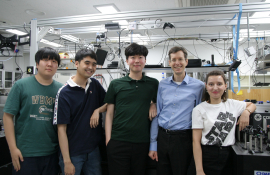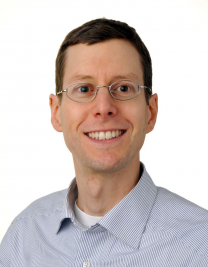- * 프린트는 Chrome에 최적화 되어있습니다. print

In the CRASY lab, we develop and use a novel type of time-domain and multi-dimensional laser spectroscopy. A single experiment yields correlated information about molecular composition (via mass spectra), nuclear structure (via rotational spectra), electronic structure (via electron spectra) and photochemical reaction pathways (via pump-probe measurements) for multiple components in a sample. We expect that the CRASY techniques will eventually transform the field of optical spectroscopy, just as the development of time-domain and multi-dimensional techniques transformed the field of NMR spectroscopy.
Research Topics:
(1) Analysis of heterogenous samples
Most molecular samples are heterogeneous and chemists routinely purify their compounds of interest, e.g., from a natural sample or a synthetic mixture. Purification is often difficult (e.g., for rare isotopologues and energetic species) and sometimes impossible (e.g., for molecular tautomers and instable species). Traditional (uncorrelated) spectroscopy shows averaged spectroscopic signals that are often insufficient to identify the structure or properties of individual sample components. Would it not be nice if we could mark each sample component and subsequently sort the spectroscopic results to assign functional properties for each component? In CRASY measurements, molecules in the sample are 'marked' by correlation to a high-resolution rotational Raman spectrum. This can be considered as a unique molecular "fingerprint" that is attached to other spectroscopic data and allows us to separate the signals from different molecules. But even better, the rotational spectrum also tells us about the shape of the molecule and can be used to analyze molecular structure with extraordinary resolution.
Work so far:
We analyzed isotopologue spectra in samples with natural isotope abundances. For CS2, we resolved 10 isotopologue rotational spectra [SCIENCE 333, 1011 (2011)] For butadiene, we identified a cationic fragmentation mechanism by analysis of isotopologue-specific fragments [JPCA 119, 1309-1314 (2015)].
Future Plans: We aim to identify hydrocarbon radical species with possible astrophysical relevance through mass-correlated rotational Raman spectroscopy. We try to observe tautomer-specific photochemical reactions in biomolecules by correlation of rotational structure and time-resolved photoelectron spectra.
(2) Broad-band THz Raman spectroscopy with better resolution and accuracy
Time-domain experiments offer an efficient way to collect broad-band spectra with good spectroscopic resolution and accuracy. As in all Fourier-transform spectroscopies, the dominant time-dependent experimental noise ("pink noise") is diluted across the whole frequency axis, thereby improving experimental contrast. Time-domain signal collection also yields phase information that is unavailable from frquency domain experiments.
Work so far:
We measured the highest-resolution rotational Raman spectra in the world, reaching 1 MHz resolution over a 500 GHz spectral range [PNAS 115, 5072 (2018), PCCP 21, 2857 (2019)]. This corresponds to an order-of-magnitude improvement on preceding literture data for rotational Raman spectroscopy and also compared to high-resolution FTIR spectroscopy. (The effective interferometer length of our current high-resolution data corresponds to ~300 m, as compared to ~12 m for the best FTIR experiments). Our high-resolution data is calibrated agains a clock, creating the first time-domain equivalent to frequency comb spectroscopy.
Future plans:
We aim for further order-of-magnitude improvements to obtain molecular spectra with kHz resolution and Hz accuracy.
Major research field
Physical Chemistry / Spectroscopy
Desired field of research
Research Keywords and Topics
Keywords: Rotational Spectroscopy, Mass Spectroscopy, Electron Spectroscopy, Pump-Probe Spectroscopy, Correlated Spectroscopy.
Topics: Isotopologue-selective measurements; Analysis of isotope effects at natural abundance; Isomer and Tautomer-selective measurements; Biomolecular spectroscopy; Analysis of reactive species; Development of high-resolution time-domain measurements.
Research Publications
MOREB.R. Özer, Heo In, J.C. Lee, C. Schröter, T. Schultz, ‘De Novo Structure Analysis of Butadiene by Mass-Resolved Rotational Raman Spectroscopy’, Phys. Chem. Chem. Phys.
21, 2857 (2019).
J.C. Lee, D.E. Lee, T. Schultz: ‘High-Resolution Rotational Raman Spectroscopy of Benzene’, Phys. Chem. Chem. Phys. 21, 2847-2860 (2019). (http://dx.doi.org/10.1039/C8CP07555G)
C. Schröter, J.C. Lee, T. Schultz, ‘Mass-Correlated Rotational Raman Spectra with High Resolution, Broad Bandwidth, and Absolute Frequency Accuracy’, Proceedings of the National Academy of Sciences USA 115, 5072 (2018).
국가과학기술표준분류
- NC. 화학
- NC01. 물리화학
- NC0103. 분광학
국가기술지도분류
- 기타 분야
- 060000. 국가기술지도(NTRM) 99개 핵심기술 분류에 속하지 않는 기타 연구




